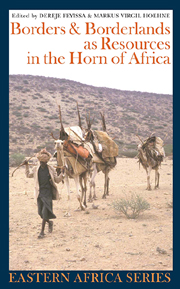Book contents
- Frontmatter
- Contents
- List of Maps, Tables & Charts
- Preface by Günther Schlee
- Editors' Preface
- Notes on Contributors
- List of Acronyms
- 1 State Borders & Borderlands as Resources
- 2 More State than the State?
- 3 Making Use of Kin beyond the International Border
- 4 The Tigrinnya-speakers across the Borders
- 5 Trans-Border Political Alliance in the Horn of Africa
- 6 People & Politics along & across the Somaliland-Puntland Border
- 7 The Ethiopian-British Somaliland Boundary
- 8 The Opportunistic Economies of the Kenya-Somali Borderland in Historical Perspective
- 9 Magendo & Survivalism
- 10 Can Boundaries not Border on One Another?
- 11 Conclusion
- Index
- EASTERN AFRICAN STUDIES
6 - People & Politics along & across the Somaliland-Puntland Border
Published online by Cambridge University Press: 05 April 2013
- Frontmatter
- Contents
- List of Maps, Tables & Charts
- Preface by Günther Schlee
- Editors' Preface
- Notes on Contributors
- List of Acronyms
- 1 State Borders & Borderlands as Resources
- 2 More State than the State?
- 3 Making Use of Kin beyond the International Border
- 4 The Tigrinnya-speakers across the Borders
- 5 Trans-Border Political Alliance in the Horn of Africa
- 6 People & Politics along & across the Somaliland-Puntland Border
- 7 The Ethiopian-British Somaliland Boundary
- 8 The Opportunistic Economies of the Kenya-Somali Borderland in Historical Perspective
- 9 Magendo & Survivalism
- 10 Can Boundaries not Border on One Another?
- 11 Conclusion
- Index
- EASTERN AFRICAN STUDIES
Summary
Introduction
Somewhere between the towns of Laascaanood and Garoowe, the only tarmac road running through the semi-desert of northern Somalia passes a dusty old bush. This bush, which stands alone within closer range, would normally not be worth mentioning. There are thousands of others along the road. But, when driving past it the second or third time, locals told me that it had a name; it was called Yoocada.1 My co-passengers added that in colonial times it indicated the border between British and Italian Somaliland. British Somaliland covered the northwest of the Somali peninsula; Italian Somaliland stretched from the northeast to the south of it.
This border was dissolved in July 1960, when both colonial territories became independent and united as the Republic of Somalia. It gained renewed significance in the context of state-collapse in Somalia. In May 1991, Somaliland seceded from the rest of Somalia in line with the borders of the former British Protectorate. Yoocada was claimed as the marker of its eastern border. This territorial rearrangement, however, is contested by Puntland which was established as an autonomous regional state in northeastern Somalia in August 1998. In contrast to Somaliland, Puntland does not pursue secession but aims at rebuilding a unitary Somali state within its pre-civil war borders. Consequently, its supporters do not accept Somaliland's self-declared independence and ignore the former colonial border. Thus, while not having a strong ‘physical’ presence, Yoocada divides people in northern Somalia politically, into those endorsing the ‘two-state’ vision of Somaliland and Somalia, and others, who adhere to the ‘one-state’ vision of a united Somalia.
- Type
- Chapter
- Information
- Borders and Borderlands as Resources in the Horn of Africa , pp. 97 - 121Publisher: Boydell & BrewerPrint publication year: 2010



